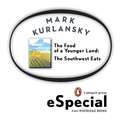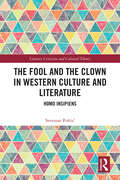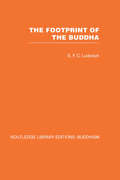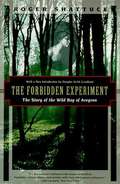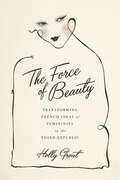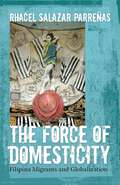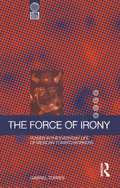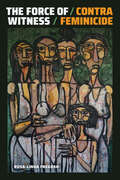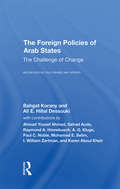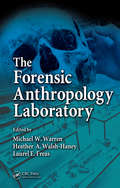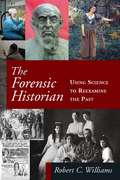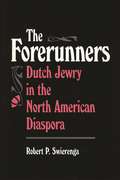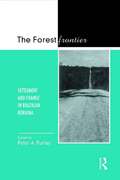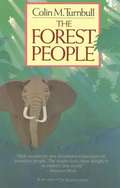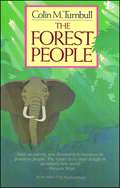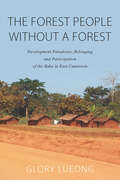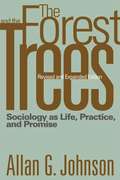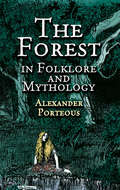- Table View
- List View
The Food of a Younger Land: The Southwest Eats New Mexico, Oklahoma, Texas, Southern California
by Mark KurlanskyAward-winning New York Times-bestselling author Mark Kurlansky takes us back to the food and eating habits of a younger America: Before the national highway system brought the country closer together; before chain restaurants imposed uniformity and low quality; and before the Frigidaire meant frozen food in mass quantities, the nation's food was seasonal, regional, and traditional. It helped form the distinct character, attitudes, and customs of those who ate it.<P> In the 1930s, with the country gripped by the Great Depression and millions of Americans struggling to get by, FDR created the Federal Writers' Project under the New Deal as a make-work program for artists and authors. A number of writers, including Zora Neale Hurston, Eudora Welty, and Nelson Algren, were dispatched all across America to chronicle the eating habits, traditions, and struggles of local people. The project, called "America Eats," was abandoned in the early 1940s because of the World War and never completed.<P> The Food of a Younger Land unearths this forgotten literary and historical treasure and brings it to exuberant life. Mark Kurlansky's brilliant book captures these remarkable stories, and combined with authentic recipes, anecdotes, photos, and his own musings and analysis, evokes a bygone era when Americans had never heard of fast food and the grocery superstore was a thing of the future. Kurlansky serves as a guide to this hearty and poignant look at the country's roots.<P> From New York automats to Georgia Coca-Cola parties, from Arkansas possum-eating clubs to Puget Sound salmon feasts, from Choctaw funerals to South Carolina barbecues, the WPA writers found Americans in their regional niches and eating an enormous diversity of meals.
The Fool and the Clown in Western Culture and Literature: Homo Insipiens (Literary Criticism and Cultural Theory)
by Svetozar PoštićThe Fool and the Clown in Western Culture and Literature: Homo Insipiens is a fascinating description of these two perennial figures in European and North American history, folklore, theater, literature, arts, and popular culture. The first part of the book separates them into ten different subcategories and recounts the most vivid and influential manifestations of different kinds of fools and clowns in cultural history. The second part singles out three European writers who have made a significant contribution to the elucidation of the concept of folly. William Shakespeare, Fyodor Dostoevsky, and Samuel Beckett have painted an entire gallery of fools, clowns, and buffoons, created not only to entertain but also to explore the meaning of human life. The most important concepts in the book are illustrated by captivating characters and tales that have made people both laugh and arrive at a deeper understanding of themselves and the world around them.
The Football Pools and the British Working Class: A Political, Social and Cultural History (Routledge Studies in Modern British History)
by Keith LaybournThis book is the first national study of the football pools in Britain which examines the politics and culture of the gambling on the football pools. It charts the rise of the football pools, focusing upon its rapid growth from the 1920s and its prolonged decline in British culture from the 1990s, partly as a result of the National Lottery. The book explores how this new gambling activity became a significant leisure opportunity for the working class - a way to feel that the individual skill of the punter could lead to the winning of some life-changing jackpot cheque being presented by a sporting personality of celebrity. Dominated by Littlewoods, and other large commercial companies, the weekly filling-in of the coupons was considered to be a safe form of investment, guaranteed by the integrity of the pool companies, rather than some seedy gambling operation. The Football Pools and the British Working Class looks at different elements of the football pools from what attracted people to this form of gambling to how the industry developed and adjusted to the suspension of the football fixtures in 1936, and the bad winter of 1962-3. Above all, it examines the deep hostility that surrounded the filling in of the football pools arising from the National Anti-Gambling League, religious groups, the football authorities and MPs. This book will appeal to all those interested in the history of British football and 20th century British working class culture.
The Footprint of the Buddha (Routledge Library Editions: Buddhism)
by E F LudowykOriginally published in 1958, this volume discusses the Buddhist monuments of Sri Lanka, which represent a distinctive and valuable portion of the art of the ancient and medieval world. It traces the development of this artistic achievement and places it in the appropriate religious, philosophical and historical context. Supporting the text are thirty-one black & white plates and a glossary of terms used helps to guide the reader throughout the book.
The Foragers of Point Hope
by Charles E. Hilton Benjamin M. Auerbach Libby W. Cowgill Charles E. Hilton Benjamin M. AuerbachOn the edge of the Arctic Ocean, above the Arctic Circle, the prehistoric settlements at Point Hope, Alaska, represent a truly remarkable accomplishment in human biological and cultural adaptations. Presenting a set of anthropological analyses on the human skeletal remains and cultural material from the Ipiutak and Tigara archaeological sites, The Foragers of Point Hope sheds new light on the excavations from 1939–41, which provided one of the largest sets of combined biological and cultural materials of northern latitude peoples in the world. A range of material items indicated successful human foraging strategies in this harsh Arctic environment. They also yielded enigmatic artifacts indicative of complex human cultural life filled with dense ritual and artistic expression. These remnants of past human activity contribute to a crucial understanding of past foraging lifeways and offer important insights into the human condition at the extreme edges of the globe.
The Forbidden Experiment: The Story of the Wild Boy of Aveyron
by Roger ShattuckRoger Shattuck offers a captivating account of this fascinating episode in intellectual history. He examines the relationships that developed among the boy, soon named Victor; Madame Guerin, the woman who fed and washed him; and Itard, the tutor who defiled his colleagues who believed the boy was hopelessly retarded.
The Force of Beauty: Transforming French Ideas of Femininity in the Third Republic
by Holly GroutThe market for commercial beauty products exploded in Third Republic France, with a proliferation of goods promising to erase female imperfections and perpetuate an aesthetic of femininity that conveyed health and respectability. While the industry's meteoric growth helped to codify conventional standards of womanhood, The Force of Beauty goes beyond the narrative of beauty culture as a tool for sociopolitical subjugation to show how it also targeted women as important consumers in major markets and created new avenues by which they could express their identities and challenge or reinforce gender norms. As cosmetics companies and cultural media, from magazines to novels to cinema, urged women to aspire to commercial standards of female perfection, beauty evolved as a goal to be pursued rather than a biological inheritance. The products and techniques that enabled women to embody society's feminine ideal also taught them how to fashion their bodies into objects of desire and thus offered a subversive tool of self-expression. Holly Grout explores attempts by commercial beauty culture to reconcile a standard of respectability with female sexuality, as well as its efforts to position French women within the global phenomenon of changing views on modern womanhood. Grout draws on a wide range of primary sources-hygiene manuals, professional and legal debates about the right to fabricate and distribute "medicines," advertisements for beauty products, and contemporary fiction and works of art-to explore how French women navigated changing views on femininity. Her seamless integration of gender studies with business history, aesthetics, and the history of medicine results in a textured and complex study of the relationship between the politics of womanhood and the politics of beauty.
The Force of Comparison: A New Perspective on Modern European History and the Contemporary World (New German Historical Perspectives #11)
by Willibald SteinmetzIn an era defined by daily polls, institutional rankings, and other forms of social quantification, it can be easy to forget that comparison has a long historical lineage. Presenting a range of multidisciplinary perspectives, this volume investigates the concepts and practices of comparison from the early modern period to the present. Each chapter demonstrates how comparison has helped to drive the seemingly irresistible dynamism of the modern world, exploring how comparatively minded assessors determine their units of analysis, the criteria they select or ignore, and just who it is that makes use of these comparisons—and to what ends.
The Force of Domesticity: Filipina Migrants and Globalization (Nation of Nations #26)
by Rhacel Salazar ParrenasTaking as her subjects migrant Filipina domestic workers in Rome and Los Angeles, transnational migrant families in the Philippines, and Filipina migrant entertainers in Tokyo, Parreñas documents the social, cultural, and political pressures that maintain women’s domesticity in migration, as well as the ways migrant women and their children negotiate these adversities.Parreñas examines the underlying constructions of gender in neoliberal state regimes, export-oriented economies such as that of the Philippines, protective migration laws, and the actions and decisions of migrant Filipino women in maintaining families and communities, raising questions about gender relations, the status of women in globalization, and the meanings of greater consumptive power that migration garners for women. The Force of Domesticity starkly illustrates how the operation of globalization enforces notions of women’s domesticity and creates contradictory messages about women’s place in society, simultaneously pushing women inside and outside the home.
The Force of Family
by Cara KrmpotichOver the course of more than a decade, the Haida Nation triumphantly returned home all known Haida ancestral remains from North American museums. In the summer of 2010, they achieved what many thought was impossible: the repatriation of ancestral remains from the Pitt Rivers Museum at the University of Oxford. The Force of Family is an ethnography of those efforts to repatriate ancestral remains from museums around the world.Focusing on objects made to honour the ancestors, Cara Krmpotich explores how memory, objects, and kinship connect and form a cultural archive. Since the mid-1990s, Haidas have been making button blankets and bentwood boxes with clan crest designs, hosting feasts for hundreds of people, and composing and choreographing new songs and dances in the service of repatriation. The book comes to understand how shared experiences of sewing, weaving, dancing, cooking and feasting lead to the Haida notion of "respect," the creation of kinship and collective memory, and the production of a cultural archive.
The Force of Irony: Power in the Everyday Life of Mexican Tomato Workers (Global Issues Ser.)
by Gabriel TorresWinner of the 'Casa Chata Award' for the Best Book of 1994 (Spanish edition)In charting the paradoxical effects of power and knowledge on the everyday life of subordinate people, this book offers a major rethinking of domination and the agricultural labor process. Challenging the belief that ethnography is theoretically weak, the author provides a fresh perspective on rural workers' responses to the development of transnational production systems and the transformations of agrarian structures brought about by the complex interactions of global and local forces. In questioning ingrained assumptions about worker consciousness, the author exposes the naivete of past approaches and the role of power and hegemony in the micro-politics of human relations. This book is obligatory reading for anyone interested in current debates about "resistance," development, and the future of rural societies.
The Force of Witness: Contra Feminicide (Dissident Acts)
by Rosa-Linda FregosoIn The Force of Witness Rosa-Linda Fregoso examines the contra feminicide movement in Mexico and other feminist efforts to eradicate gender violence. Drawing on interviews, art, documentaries, and her years of activism, Fregoso traces the micro and macro scales of misogyny and the patterns of state complicity with gender violence. She shows how different forms of witnessing—from activist-mothers’ bearing witness to the memories of their daughters and expert witnesses in court cases to communal witnessing and a scholar-activist-citizen witnessing her own actions—are key to resisting feminicidal violence. Fregoso situates these forms of witness in the histories, contexts, structures, bodies, and intersectional struggles they emerge from. By outlining the complexities of feminicidal violence in relation to witnessing processes, Fregoso challenges the notion of witness as an individual or autonomous subject inscribed solely in the legal or religious arenas. Rather, she theorizes witness as a force of collectivity and a constellation of multiple social locations and intersectional practices that work together to abolish feminicidal violence.
The Foreign Policies Of Arab States: The Challenge Of Change
by Bahgat Korany Ali El-Din DessoukiMiddle East politics have been proverbial for their changeability. The 1970s ushered in petro-politics, for instance, but OPEC's international status declined markedly in the following decade. Similarly, the Arab world's ostracism of Egypt in the 1970s following its separate peace with Israel was turned around in the 1980s; the late 1980s also brought PLO acceptance of the State of Israel. Interstate relations were not the only arena to experience significant alterations; state-society relations also underwent dramatic changes, such as the acceleration of privatization in erstwhile socialist regimes. Then the 1990s opened with a political earthquake: the Gulf Crisis. The second edition of this highly acclaimed text offers a penetrating analysis of trends in Arab foreign policies since the book was originally published in 1984, including an early analysis of the effects of Iraq's invasion of Kuwait and the subsequent coalition victory over Iraq. In addition, the authors have included new chapters on Jordan—at the heart of the Arab world—and on the Sudan—the region's link to sub-Saharan Africa. Their inclusion allows a fuller understanding of the foreign policies of states that occupy crucial geopolitical positions but wield little tangible power. Moreover, in many of its chapters the book raises the crucial question of how the foreign policies of these countries can cope with the prevalence of political change.
The Forensic Anthropology Laboratory
by Michael W. Warren Heather A. Walsh-Haney Laurel E. FreasWhile other books cover general topics and various subsets of forensic anthropology, this one-of-a-kind reference compiles the best practices of policies, procedures, and protocols of different laboratories across the world. This book brings together experts in every aspect of forensic anthropology to consider physical plant demands, equipment needs, staffing, ethical issues, and the process of certification with the American Society of Crime Laboratory Directors. With examples of implementation, The Forensic Anthropology Laboratory also provides discussion of proven methods in skeletal preparation, laboratory flow, and specimen curation including processing logs and sample forms.
The Forensic Historian: Using Science to Reexamine the Past
by Robert C WilliamsModern forensic science has significantly affected historical debate over some well-known past crimes or mysteries, utilizing modern DNA, nuclear, and chemical analyses to reexamine the past. This book takes an in-depth look at 20 significant cases where investigators have applied new forensic techniques to confirm, dispute, or revise accepted historical accounts. Among the cases included are the murder of King Tut, the validity of the Vinland Map, the authenticity of the Hitler diaries, Joan of Arc's ashes, the bones of Anastasia, arsenic and the death of Napoleon, and the dating of the Shroud of Turin, plus 13 more.
The Forerunners: Dutch Jewry in the North American Diaspora (American Jewish Civilization Series)
by Robert P. SwierengaBetween 1800 and 1880 approximately 6500 Dutch Jews immigrated to the United States to join the hundreds who had come during the colonial era. Although they numbered less than one-tenth of all Dutch immigrants and were a mere fraction of all Jews in America, the Dutch Jews helped build American Jewry and did so with a nationalistic flair. Like the other Dutch immigrant group, the Jews demonstrated the salience of national identity and the strong forces of ethnic, religious, and cultural institutions. They immigrated in family migration chains, brought special job skills and religious traditions, and founded at least three ethnic synagogues led by Dutch rabbis. <P><P> The Forerunners offers the first detailed history of the immigration of Dutch Jews to the United States and to the whole American diaspora. Robert Swierenga describes the life of Jews in Holland during the Napoleonic era and examines the factors that caused them to emigrate, first to the major eastern seaboard cities of the United States, then to the frontier cities of the Midwest, and finally to San Francisco. He provides a detailed look at life among the Dutch Jews in Boston, New York, Philadelphia, Baltimore, and New Orleans. This is a significant volume for readers interested in Jewish history, religious history, and comparative studies of religious declension. Immigrant and social historians likewise will be interested in this look at a religious minority group that was forced to change in the American environment.
The Forest Frontier: Settlement and Change in Brazilian Roraima
by Edited by Peter A. FurleyDestructive patterns of Amazonian evolution are now infecting relatively untouched Northern Brazil - driven by the gold rush and demographic and economic forces from the South. The Forest Frontier assesses whether the Northern Amazonian States can avoid the same pressures and problems that affect the peoples and environments of the South. It examines the social and environmental nature of land development in Roraima, the most northerly of the Brazilian Amazonian states. Possessing most of the classic problems facing other States as well as containing a combination of political, cultural and environmental features, Roraima's development is at a frontier. Offering a critical assessment of the nature and pace of agricultural advance into Roraima, The Forest Frontier will provide a better understanding to plan for the inevitable development to come.
The Forest People
by Colin M TurnbullThe Forest People is an astonishingly intimate and life-enhancing account of a hunter-gatherer tribe living in harmony with nature -- and an all-time classic of anthropology.For three years, Colin Turnbull lived with an isolated group of Pygmies deep in the forest of the African Congo, experiencing their daily life first-hand. He attended their hunting parties and initiation ceremonies, witnessed their music and their rituals, observed their quarrels and love affairs. He documented them as an anthropologist but was accepted among them as a friend.A ground-breaking work in its time, The Forest People made him one of the most famous intellectuals of the 1960s and 1970s. It remains a transporting account of an earthly paradise and of a legendary and fascinating people.With a new foreword by Horatio Clare.
The Forest People
by Colin M. TurnbullBook describes the author's experiences while living with the BaMbuti Pygmies, not as a clinical observer, but as their friend, learning their customs and sharing their daily life. Turnbull conveys the lives and feelings of the BaMbuti whose existence centers on their intense love for their forest world, which, in return for their affection and trust, provides their every need.
The Forest People
by Colin TurnbullThe Forest People -- Colin M. Turnbull's best-selling, classic work -- describes the author's experiences while living with the BaMbuti Pygmies, not as a clinical observer, but as their friend learning their customs and sharing their daily life. Turnbull conveys the lives and feelings of the BaMbuti whose existence centers on their intense love for their forest world, which, in return for their affection and trust, provides their every need. We witness their hunting parties and nomadic camps; their love affairs and ancient ceremonies -- the molimo, in which they praise the forest as provider, protector, and deity; the elima, in which the young girls come of age; and the nkumbi circumcision rites, in which the villagers of the surrounding non-Pygmy tribes attempt to impose their culture on the Pygmies, whose forest home they dare not enter. The Forest People eloquently shows us a people who have found in the forest something that makes their life more than just living -- a life that, with all its hardships and problems and tragedies, is a wonderful thing of happiness and joy.
The Forest People
by Colin TurnbullThe bestselling, classic text on one anthropologist's incredible experience living among the African Mbuti Pygmies, and what he learned from their culture, customs, and love of life.In this bestselling book, Colin Turnbull, a British cultural anthropologist, details the incredible Mbuti pygmy people and their love of the forest, and each other. Turnbull lived among the Mbuti people for three years as an observer, not a researcher, so he offers a charming and intimate firsthand account of the people and their culture, and especially the individuals and their personalities. The Forest People is a timeless work of academic and humanitarian significance, sure to delight readers as they take a trip into a foreign culture and learn to appreciate the joys of life through the eyes of the Mbuti people.
The Forest People without a Forest: Development Paradoxes, Belonging and Participation of the Baka in East Cameroon
by Glory M. LueongDevelopment interventions often generate contradictions around questions of who benefits from development and which communities are targeted for intervention. This book examines how the Baka, who live in Eastern Cameroon, assert forms of belonging in order to participate in development interventions, and how community life is shaped and reshaped through these interventions. Often referred to as ‘forest people’, the Baka have witnessed many recent development interventions that include competing and contradictory policies such as ‘civilize’, assimilate and integrate the Baka into ‘full citizenship’, conserve the forest and wildlife resources, and preserve indigenous cultures at the verge of extinction.
The Forest and the City: The Cultural Landscape Of Urban Woodland
by Cecil C. KonijnendijkAmsterdamse Bos, Bois de Boulognes, Epping Forest, Hong Kong’s country parks, Stanley Park: throughout history cities across the world have developed close relationships with nearby woodland areas. In some cases, cities have even developed – and in some cases are promoting – a distinct ‘forest identity’. This book introduces the rich heritage of these city forests as cultural landscapes, and shows that cities and forests can be mutually beneficial.Essential reading for students and researchers interested in urban sustainability and urban forestry, this book also has much wider appeal. For with city forests playing an increasingly important role in local government sustainability programs, it provides an important reference for those involved in urban planning and decision making, public affairs and administration, and even public health. From providers of livelihoods to healthy recreational environments, and from places of inspiration and learning to a source of conflict, the book presents examples of city forests from around the world. These cases clearly illustrate how the social and cultural development of towns and forests has often gone hand in hand. They also reveal how better understanding of city forests as distinct cultural and social phenomena can help to strengthen synergies both between cities and forests, and between urban society and nature.
The Forest and the Trees: Sociology as Life, Practice, and Promise
by Allan G. JohnsonIf sociology could teach everyone just one thing, what would it be? The Forest and the Trees is one sociologist's response to the hypothetical--the core insight with the greatest potential to change how people see the world and themselves in relation to it. This revised and updated edition features: * A new chapter that brings together the various aspects of the sociological model described in previous chapters with a detailed application to the origins of racism in the United States * A discussion of how individuals can participate in social change by stepping off paths of least resistance * The addition of graphics to illustrate the sociological model of systems and individuals
The Forest in Folklore and Mythology
by Alexander PorteousAssembled from an enormous range of sources, this fascinating book is a mind-expanding compendium of facts, folklore, superstitions, myths, and anecdotes about trees and the forest. Included are descriptions of old forests; forest customs, temples and sacred groves; mythical forest creatures such as witches, fairies, demons, wood spirits, the "wild huntsman," and wood nymphs.The author also recounts facts and fables about individual trees, including famous trees throughout the world, unusual trees, tree worship, people's transformation into trees, and disposal of the dead in trees — as well as folklore about fossil trees, tree bark, leaves, thorns, diving rods, and Yule logs.This long-unavailable treasury of legend and lore will be welcomed by naturalists, anthropologists, students of folklore, and general readers alike.
